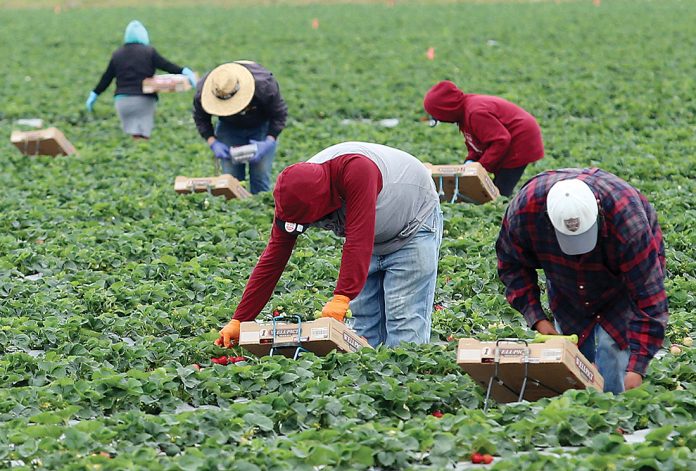
WATSONVILLE—The Watsonville area has the lowest number of COVID-19 cases in Santa Cruz County, according to data from the county health department.
There were 29 known COVID-19 cases in South County as of Wednesday, compared to 33 in North County and 45 in Mid-County. North Monterey County, which includes nearby towns Pajaro and Las Lomas, had eight cases as of Wednesday.
It is not publicly known which towns those cases are from.
When asked why the number of cases in South County was lower than in other regions, Santa Cruz County Department of Public Health Director Mimi Hall at recent press conference theorized that fear of deportation was keeping the area’s large undocumented community at home and slowing the spread.
Santa Cruz County Health Officer Dr. Gail Newel agreed and said it is possible that the region has been undertested because of a reluctance or inability to access healthcare.
Advocates believe that is true and have called on lawmakers to help what they call one of the most “vulnerable” populations in California.
Gov. Gavin Newsom recently said the will state provide 150,000 undocumented adults a one-time cash benefit of $500 per adult with a cap of $1,000 per household to deal with the COVID-19 pandemic. Other philanthropists also chipped in an additional $50 million to help undocumented immigrants.
The state said individuals can apply for support beginning next month.
Santa Cruz Community Ventures CEO Maria Cadenas called Newsom’s plan a “good start,” but said more help was needed, highlighting the 2.8 million undocumented individuals across California and the 92,000 living and working in the Monterey Bay.
That’s why she partnered with a half-dozen other nonprofits from around the Central Coast to create UndocuFund Monterey Bay, a grassroots pool of cash that will be distributed to undocumented people in both Santa Cruz and Monterey counties. They plan to distribute every penny within 30 days after it has been donated.
SCCV will not take any administrative fees from the fund, and all information shared will be private, Cadenas said.
“The most important thing people need right now is easy access to cash that is flexible,” she said.
Yet Cadenas understands that promise of privacy will not be enough for some undocumented people still living in fear after “years of anti-immigrant sentiment.” Those residents, she and several other nonprofit leaders said, will continue to avoid financial and medical help for those reasons, and the county will not have a true picture of how widespread the virus is in the Pajaro Valley.
“When we talk to the county, even prior to COVID-19, they had seen declining involvement and use of medical benefits for undocumented or mix-status households,” she said. “I’m very humbled and continuously encouraged by the work the county is doing. At the same time, there are so many inequities that we have to address as a community that when this happens they get worse—they become much more visible. I don’t think the low caseload indicates somehow there’s less cases.”
County officials as of Thursday afternoon did not know how many South County residents had been tested, and despite their efforts to ramp up testing capacity, they said mass testing is still weeks away.
PLANNING AHEAD
With the summer strawberry harvesting season on the horizon, Hall said the county must turn its attention to the agricultural community, which is buoyed by the area’s undocumented immigrants.
Among her concerns: how do they assure farmworkers are following physical distancing requirements and how can they quickly identify a positive test and safely move that person into self-isolation?
Neighboring Monterey County was the first agency in the state to set up protections for its farmworkers, releasing guidelines in late March for those still performing “essential” labor during the shelter-in-place order. That advisory established rules for hygiene and physical distancing and called for mandatory training on the Centers for Disease Control and Prevention rules for all employees.
Other agencies around the state also implemented their own guidelines for agriculture, but Santa Cruz County has not. Instead, they have put that responsibility on growers. Most have followed guidance from their respective commissions such as the California Strawberry Commission, which has provided growers across the state daily direction through email since the beginning of the pandemic. Those commands have come in many forms, including informational packets, mandatory training and various video public service announcements in English, Spanish and Mixtec, a dialect spoken by natives from Mexican states Oaxaca, Puebla and Guerrero.
Still, growers have faced scrutiny for not doing enough for their workers during the COVID-19 crisis, pointing to a recent outbreak in Monterey County in which 16 farmworkers tested positive. Santa Cruz County Farm Bureau Executive Director Jess Brown said that criticism is unfair and that all growers are trying to protect their workforce.
“That’s where I disagree. I think they’re doing a great deal to help farmworkers and keep them safe,” Brown said. “They know they need a healthy workforce.”
Local growers and county officials on Wednesday held the first of what will be a weekly conference call in which they will discuss how to handle a possible COVID-19 outbreak in the agriculture workforce, among other things. From those conferences, which were spearheaded by County Supervisor Zach Friend, the county hopes to identify temporary housing and healthcare options for farmworkers who test positive and need to self-isolate or require medical attention but do not want to jeopardize their immigration status.
That would be a big win for growers and their employees, many of which live in cramped conditions around South County. With roughly 7,600 people per square mile, Watsonville is by far the most densely populated location in the county—Santa Cruz, comparatively, has 3,900 people per square mile.
A big reason for that crowding, Watsonville Mayor Rebecca Garcia said, is the multigenerational living arrangements commonly found in Hispanic and Latino families. Garcia said she has raised concerns to the county about those living situations but has not yet received a response.











